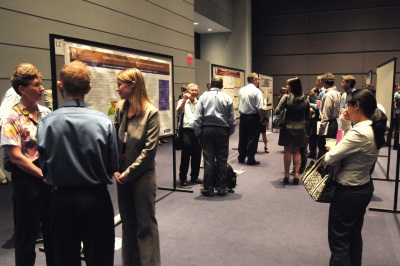
Poster Presentations
Posters presented during the Annual Meeting will each be on display for one day (either Monday or Tuesday) and will be part of the Poster Presentation Session on that day.
Poster Schedule
Each Poster will be displayed at one particular meeting time. The scheduled presentation day determines when the Poster will be on display. The setup and take down times for each presentation time are available below:
Monday Poster Presentation Session

Poster Setup:
Monday, August 13, 7:00 am – 11:30 pm
Poster Presentation Session:
Monday, August 13, 2:45 pm – 4:15 pm
Poster Take Down:
Monday, August 13, 4:30 pm – 6:30 pm
Tuesday Poster Presentation Session
Poster Setup:
Tuesday, August 14, 7:00 am – 11:30 pm
Poster Presentation Session:
Tuesday, August 14, 2:15 pm – 3:45 pm
Poster Take Down:
Tuesday, August 14, 4:30 pm – 6:30 pm
Tours of Selected Posters
Ten poster tours will take place on both Monday and Tuesday, highlighting a total of about 100 Posters. The most popular subject codes will be used as the basis for each tour, helping to ensure that each tour will focus on a different topic. Posters will be chosen for the tours based on a wide range of criteria, and are not meant to reflect the quality of those chosen.
Tours will feature an author of each Poster presenting their research for ten minutes, followed by a short time for discussion. Each tour will be open to all meeting attendees, and will end with enough time left for attendees to visit the other Posters in the hall. Attendees do not need to register in advance to attend a tour.
AgEcon Search Submissions
All AAEA Posters must be submitted to AgEcon Search by June 4. Please consult the instructions for submission for more information.
Poster Examples
Below you will find a few posters that were displayed at the 2011 Joint Annual Meeting. They are all great examples of how to communicate information in an effective and interesting way visually.
- Consumer Preferences for Attributes of Organic Processed Foods: The Case of Soymilk In the United States
Zheng, Yue; Peterson, Hikaru Hanawa; Li, Xianghong - An Economic Analysis of Water Infrastructure Investments, Agricultural Productivity and Climate Change in the Mekong Delta: Adapting to Increased Salinity and Sea Level Rise
Corderi Novoa, David; Williams, Jeffrey C.; Howitt, Richard E.; Lund, Jay R. - Biofuels, Climate Policy, And Water Management: Assessing Policy-Induced Shifts on Agriculture's Extensive and Intensive Margins
Baker, Justin Scott; Murray, Brian C.; McCarl, Bruce A. - A Study on the International Marketing and Branding Strategies of Taiwan's Phalaenopsis Orchid Industry
Chang, Ching-Cheng; Wu, Chia-Hsun - Biomass Supply from Alternative Cellulosic Crops and Crop Residues: A Spatial Bioeconomic Modeling Approch
Egbendewe-Mondzozo, Aklesso; Swinton, Scott M.; Izaurralde, R. Cesar; Manowitz, David H.; Zhang, Xuesong
Poster Design
To help you develop your poster, we have provided a few suggestions below. This is meant as a general overview to get you started.
Poster Size
The maximum poster size is 4 feet high by 8 feet long, minus a 1-inch margin. Your actual poster may be smaller. Pushpins will be provided for you to hang your poster.
Content
- Introduction: Provide context for your research. Why you are excited about it?
- Objectives: What questions did you address or answer?
- Methods: Key information on your research design and analysis. Keep it brief.
- Results & Discussion: What was observed? How do the results relate to the original questions? Focus on the key points.
- Conclusions: What did you learn?
Replace text with graphical elements as much as possible (e.g., photographs or maps of study's location, other visual aids to convey key results), but do not forget your complete contact information. Consider including a photograph of the presenting author.
Layout
Clearly indicate your key message. Avoid clutter and unnecessary detail. Don't fight the reader's gravity-pull from top to bottom and left to right. Remember graphical elements, such as balance, symmetry, rhythm, repetition, and change.
Aesthetics
Any text in your poster should be readable from 6 feet away, including text in figures. This means no text should be smaller than a 20-point font. The title must be much larger and readable from a distance (12 feet or more).
Use fonts without serif, but bold. Use dark letters on light backgrounds. Use color carefully; very bright colors can easily fatigue the reader. Stick to a theme of 2-3 colors.
Useful Guidelines
Tips for Creating a Poster in PowerPoint
from AgEcon Search
BetterPosters.blogspot.com
"Academics use posters to present research, but their posters are often ugly, with tiny text, confusing layouts, and dubious colour schemes. Better Posters is about making posters informative and beautiful."









